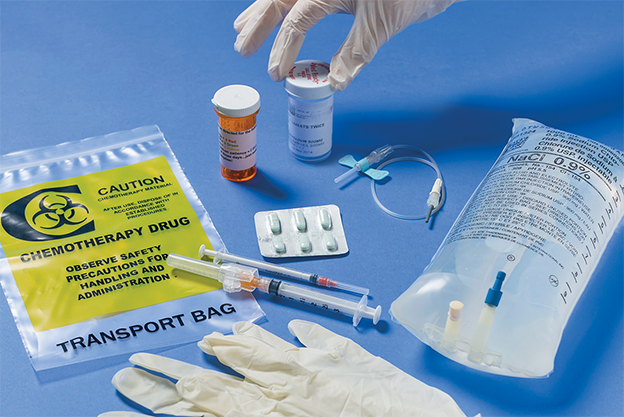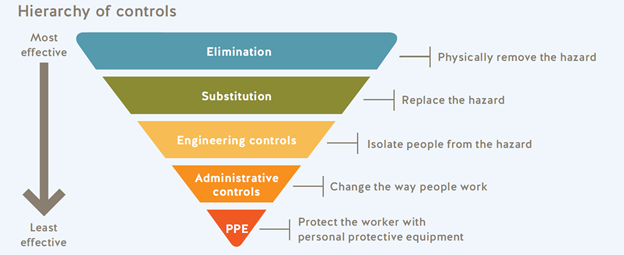Reducing the risk of exposure to antineoplastic drugs in veterinary clinics and hospitals
Antineoplastic drugs are used to treat cancer, as well as arthritis, multiple sclerosis, and other non-cancer conditions. Because they can alter cellular functions at a low dosage, workers who work with or near antineoplastic drugs are at risk of exposure and associated adverse health effects. Learn the steps that employers and workers should follow to eliminate or effectively reduce the risk of exposure. .
What are the adverse health effects of antineoplastic drugs?
Health effects can be acute (rapid onset following exposure) and chronic (develop slowly over time). Acute effects include nausea, dizziness, rashes, gastrointestinal problems, and hair loss. Chronic effects include cancers and negative reproductive outcomes, such as infertility, miscarriage, and birth defects.
There is no safe exposure level for antineoplastic drugs. Employers must keep workers’ exposure to antineoplastic drugs as low as reasonably achievable (ALARA).
How do exposures occur?
Workers may be exposed to antineoplastic drugs directly while handling these drugs, or indirectly via contact with contaminated surfaces and objects in the workplace.
Exposure to antineoplastic drugs can occur through:
- Inhalation
- Absorption through skin or mucous membranes
- Ingestion
- Injection from a needlestick injury
Examples of exposure events may include:
- Handling incoming shipments of antineoplastic drugs that may have surface contamination on vials or packaging materials
- Preparing and mixing antineoplastic drugs (e.g., crushing pills, drug reconstitution), and priming administration equipment, which can cause spills and release antineoplastic drug particulates or vapours into the air
- Administering drugs through IV that can cause spills or accidental needlestick injuries
- Handling the waste of treated animals (e.g., blood, vomit, stool, urine, sweat) or their contaminated bedding, cages, and kennels, since antineoplastic drugs can be excreted for 72 hours or more following chemotherapy treatment
Who is at risk?
Workers in veterinary settings who may be at risk include:
- General veterinarians and specialty veterinarians
- Veterinary technologists or technicians
- Veterinary assistants
- Pharmacists handling veterinary antineoplastic drugs
- Other supporting staff working in veterinary clinics or hospitals
- Janitorial and laundry workers
- Hazardous drug disposal and waste removal contractors
According to 2016 data from CAREX (CARcinogen EXposure) Canada, 3,500 veterinarians and 2,800 veterinary technicians are estimated to be exposed to antineoplastic drugs at work. These veterinary occupations are fifth and sixth, respectively, on the list of occupations with the most number of exposed workers in Canada.
In 2021 and 2022, WorkSafeBC conducted a series of inspections in both general and oncology-specialty veterinary clinics and hospitals. Inspections discovered workers were at higher risk of exposure in general veterinary clinics and hospitals that occasionally provided chemotherapy treatment and were not equipped with adequate equipment (e.g., biological safety cabinet for drug preparation). These workplaces were less aware of the hazards of antineoplastic drugs and the suitable controls to reduce the risk of worker exposure.
How can employers reduce the risk of exposures?
To eliminate or effectively reduce the risk of exposures in the workplace, employers and workers should work together to follow the steps described below.
Step 1: Understand the risks
Identify the hazards by determining what antineoplastic drugs are present at the workplace and where they are stored and handled.
Next, conduct a thorough risk assessment for both routine work activities and emergency work activities (e.g., spill cleanup) involving antineoplastic drugs to determine how exposure may occur, and who may be at risk of exposure.
Step 2: Implement measures to control the risks
After a risk assessment is completed, employers should select and implement effective controls, based on the hierarchy of controls, illustrated below.
The following are examples of controls for each of the hierarchy levels:
- Elimination controls
- Refer patients to specialty oncology hospitals, if your workplace is not equipped to handle antineoplastic drugs safely
- Remove unneeded antineoplastic drugs from the workplace
- Have drugs prepared and primed by a pharmacy and delivered in a form that is ready to administer
- Substitution controls
- Use a form of antineoplastic drugs that has a lower risk of exposure to workers, such as coated tablets instead of IV infusions (if clinically appropriate)
- Engineering controls
- Install and use biological safety cabinets (class II type B or greater)
- Use a closed-system drug-transfer device
- Administrative controls
- Develop safe operating procedures
- Provide worker training and maintain drug-handling records for each worker
- Identify animals who have received hazardous drugs (e.g., place signs on cages or kennels)
- Post warning signs in areas where antineoplastic drugs are present
- Maintain a list of all antineoplastic drugs present in the workplace
- Personal protective equipment (PPE)
- Provide workers with PPE — such as chemotherapy-tested gloves and gowns, approved fit-tested respirators, eye and face protection, footwear, and shoe covers — and ensure they wear them as specified in your workplace’s safe work procedures
Step 3: Communicate with workers and others at the workplace
Make sure workers are trained on and aware of new information related to the hazards of antineoplastic drugs, associated adverse health effects from exposure, and controls implemented to reduce risk of exposure.
Step 4: Regularly monitor and update your control measures
Managing workplace risks is an ongoing, cyclical process for employers to monitor how effectively they are reducing the risk of exposures in their workplaces. It’s important employers repeat the previous three steps whenever there are changes in the workplace or when control measures are not working as intended.
When evaluating your control measures, consider questions such as: Is the list of antineoplastic drugs in your workplace accurate and current? Are you aware of all the surfaces and items that may potentially be contaminated with antineoplastic drugs? Are workers following safe work procedures?
See Managing risk for more information about how to manage the risk in your workplace.
Additional information and resources
For more information about reducing the risk of exposure to antineoplastic drugs in veterinary workplaces, see the following resources:
- Antineoplastic drugs in veterinary clinics and hospitals: Are you at risk of exposure? Information for workers
- Best Practices for the Safe Handling of Hazardous Drugs (see section 17 for specific information for veterinary practices)
- Basics of risk management: Four steps to a healthy and safe workplace
- WorkSafeBC Risk Advisory: Hazardous drug exposure
For regulatory information relating to antineoplastic (cytotoxic) drugs in B.C. workplaces, see sections 6.42–6.58 of the Occupational Health and Safety Regulation.
If you have any health and safety questions or would like information and assistance with health and safety issues in the workplace, call the WorkSafeBC Prevention Information Line at 604.276.3100 (Lower Mainland) or toll-free at 1.888.621.7233 (Canada).


